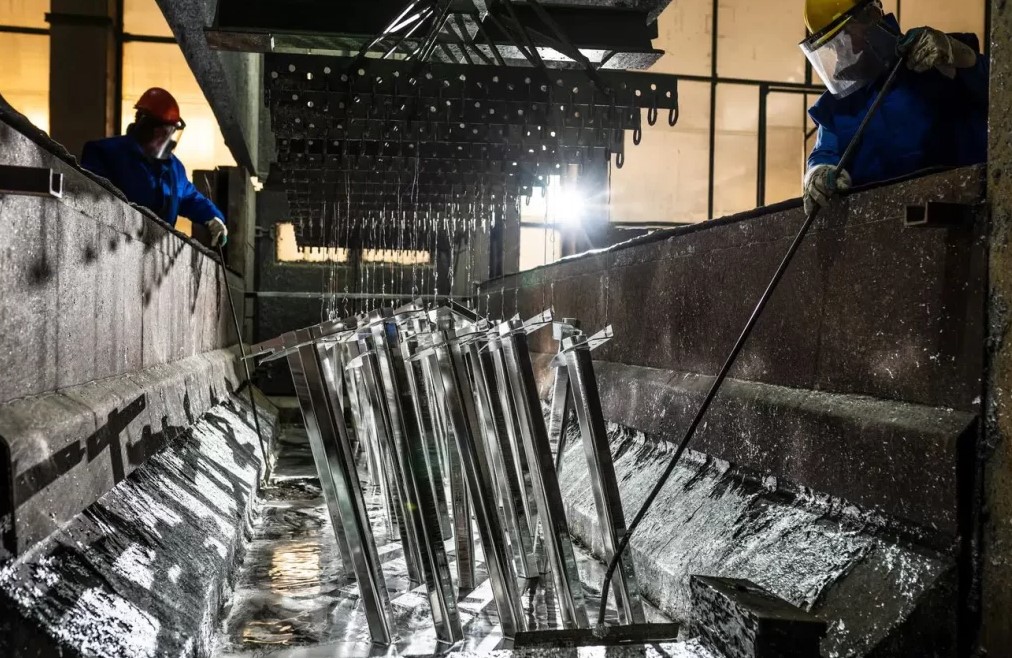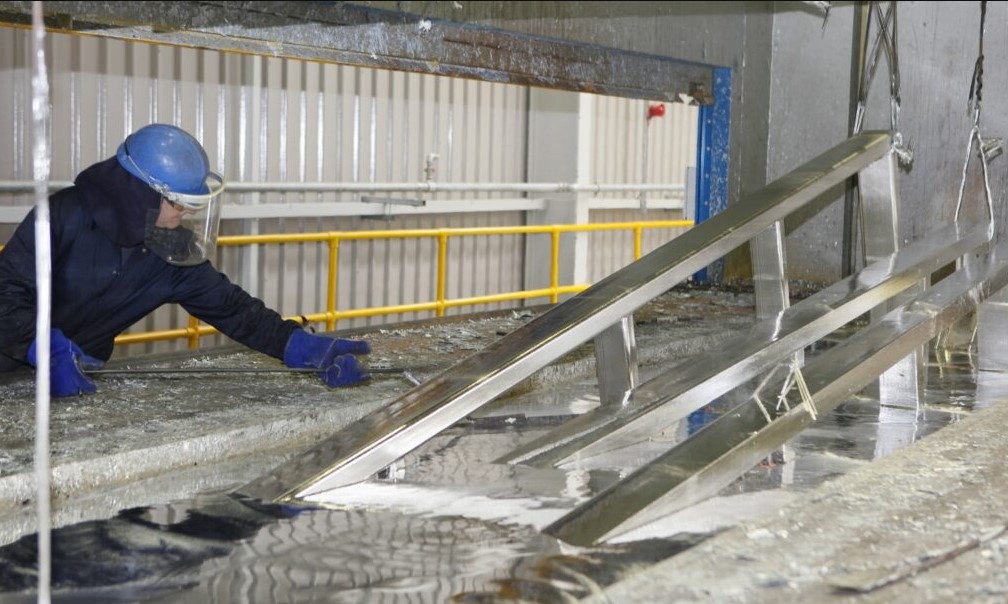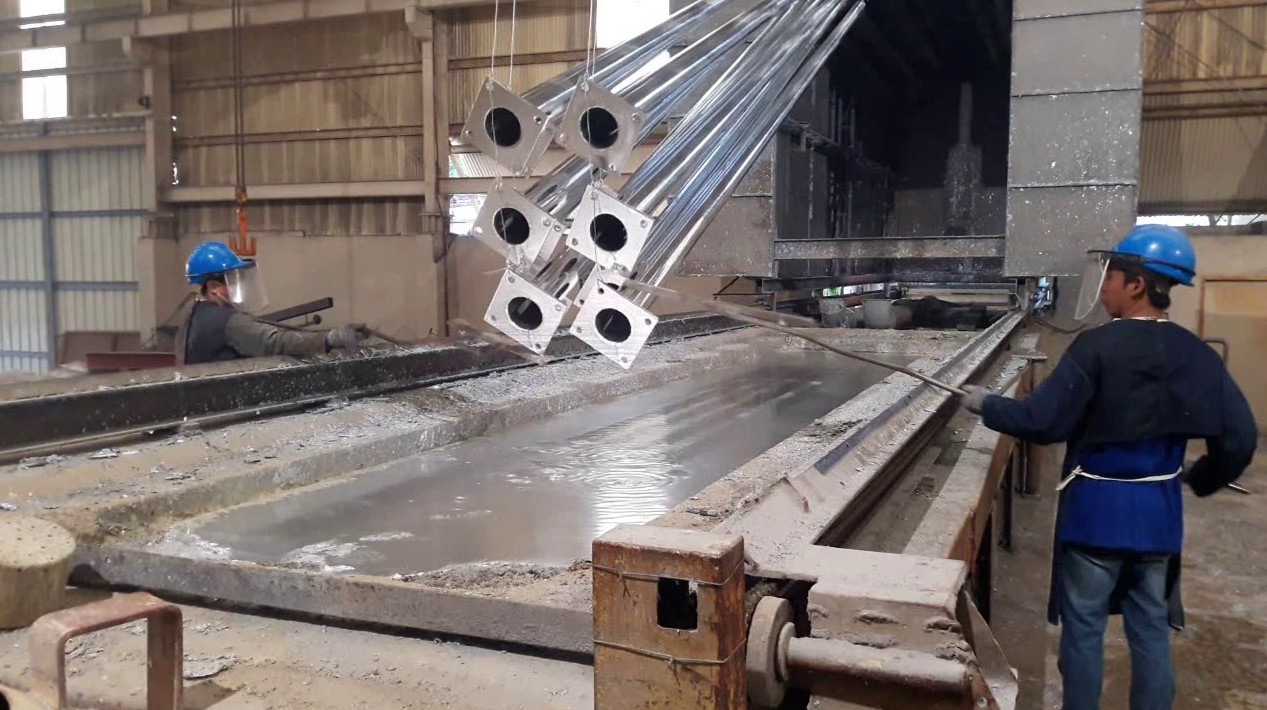As a leading industrial metal supplier, Stavian Industrial Metal provides in-depth insights into hot dip galvanizing zinc, a process widely recognized for enhancing steel durability and corrosion resistance. By immersing steel in molten zinc, this technique creates a robust protective layer that extends product lifespan, minimizes maintenance costs, and ensures long-term performance in harsh environments. With advanced technology and strict quality control, Stavian Industrial Metal delivers galvanized materials that meet international standards, making them ideal for construction, manufacturing, and infrastructure projects worldwide.
At Stavian Industrial Metal, we define hot dip galvanizing zinc as a metallurgical process designed to protect steel and iron from corrosion through the application of a zinc coating. This process involves immersing clean steel components into a bath of molten zinc heated to approximately 450°C (840°F). The reaction between iron and zinc forms a tightly bonded alloy layer that serves as a durable and long-lasting shield against rust, oxidation, and environmental damage.
The resulting coating is not merely a surface layer—it becomes an integral part of the steel itself. The metallurgical bond ensures superior adhesion, preventing peeling or flaking even under harsh mechanical stress. This makes hot dip galvanizing zinc one of the most effective and economical corrosion protection methods used across multiple industries today.

The quality of the final zinc coating depends largely on the precision of each production stage. At Stavian Industrial Metal, we follow a strict and standardized sequence to ensure consistency and reliability in every batch:
Surface Preparation: The steel is thoroughly cleaned through degreasing, pickling, and fluxing to remove all contaminants such as oil, rust, and mill scale. This ensures optimal zinc adhesion.
Immersion in Molten Zinc: The cleaned steel is submerged in a molten zinc bath at controlled temperature. The zinc reacts with the iron in the steel to form several zinc-iron alloy layers.
Cooling and Inspection: After galvanizing, the material is slowly cooled in ambient air or water. Each piece undergoes visual inspection and coating thickness measurement to verify compliance with international standards.
Finishing: If necessary, excess zinc is removed, and the surface may be passivated to improve aesthetic appearance and enhance corrosion resistance.
This structured workflow not only guarantees the mechanical and chemical quality of the coating but also ensures that each product from Stavian Industrial Metal maintains exceptional performance throughout its service life.
The most notable advantage of hot dip galvanizing zinc is its exceptional ability to protect steel from corrosion in a wide range of environments—urban, rural, industrial, and marine. The zinc coating acts as both a physical barrier and a sacrificial anode. When exposed to moisture or oxygen, zinc oxidizes preferentially, shielding the underlying steel from corrosion.
This electrochemical protection ensures that even if the coating is scratched or damaged, the exposed steel remains protected through cathodic action. According to long-term studies, hot dip galvanized steel can last over 50 years in rural environments and 20–30 years in highly corrosive industrial atmospheres without major maintenance.
Unlike other coating methods such as painting or electroplating, hot dip galvanizing forms a metallurgical bond between zinc and steel. This intermetallic structure makes the coating extremely tough and resistant to abrasion, impact, and rough handling.
This property is particularly valuable in applications involving heavy-duty structures like bridges, industrial platforms, transmission towers, and offshore facilities. At Stavian Industrial Metal, our galvanized products undergo rigorous mechanical testing to ensure they can withstand high loads and mechanical stress while maintaining their protective integrity.
While the initial cost of hot dip galvanizing may be slightly higher than other anti-corrosion methods, it offers superior long-term cost efficiency. Because the zinc coating provides decades of protection without frequent repainting or repairs, the total life-cycle cost of galvanized steel is significantly lower.
Additionally, galvanized surfaces require minimal maintenance, reducing downtime and labor costs for infrastructure operators. For investors and construction managers, this means reliable protection, predictable budgeting, and fewer operational disruptions over time.

Hot dip galvanizing zinc is a cornerstone of modern infrastructure development. In the construction sector, galvanized steel is extensively used in structural frameworks, roofing systems, handrails, and safety barriers. The zinc coating prevents steel degradation even in outdoor and coastal environments where humidity, salt, and pollution accelerate corrosion.
Stavian Industrial Metal supplies galvanized steel beams, angles, and channels that meet ASTM A123 and ISO 1461 standards—two of the most recognized benchmarks for coating quality. Our materials are trusted in high-rise buildings, bridges, and large-scale industrial complexes where durability and long-term performance are essential.
The energy sector heavily depends on galvanized steel for the construction of transmission towers, wind turbine foundations, and solar panel mounting systems. Hot dip galvanizing zinc provides the reliability needed to withstand outdoor exposure, high humidity, and varying temperatures.
In renewable energy projects, galvanized steel structures ensure that solar and wind installations maintain structural integrity throughout their lifespan, reducing maintenance intervals and maximizing return on investment. Stavian Industrial Metal offers custom galvanizing solutions tailored to meet the specific needs of renewable infrastructure projects.
Transportation infrastructure, including highways, railways, and ports, demands materials that can endure constant exposure to harsh weather and mechanical wear. Hot dip galvanizing zinc is ideal for such environments because it offers both mechanical strength and superior corrosion resistance.
Galvanized guardrails, light poles, road signs, and shipyard structures benefit from the protective zinc coating, ensuring safety and reliability. In marine environments, where saltwater corrosion is a major challenge, hot dip galvanized steel is often the preferred material for piers, docks, and offshore platforms.

The composition of the molten zinc bath plays a critical role in the quality of the final coating. The base element is pure zinc (Zn) with a purity of at least 99.95%, often alloyed with trace elements such as aluminum (Al), nickel (Ni), and bismuth (Bi) to enhance coating uniformity and surface finish.
At Stavian Industrial Metal, we use high-grade zinc conforming to ASTM B6 standards, ensuring low impurity levels and consistent metallurgical bonding. The addition of minor elements improves fluidity, reduces dross formation, and minimizes coating thickness variations, leading to a smoother and more uniform surface.
A distinctive characteristic of hot dip galvanizing zinc is the formation of multiple alloy layers between steel and zinc, each contributing to overall strength and corrosion protection. From the innermost to outermost, these include:
Gamma (Γ) layer: A zinc-iron alloy with approximately 75% zinc and 25% iron, forming the foundation of the bond.
Delta (δ) layer: Composed of 90% zinc and 10% iron, providing high hardness and adhesion.
Zeta (ζ) layer: A tough yet flexible layer with about 94% zinc and 6% iron.
Eta (η) layer: The pure zinc outer layer that offers excellent corrosion resistance and a bright metallic appearance.
This multi-layered structure ensures not only superior protection but also exceptional impact resistance and thermal stability, making it ideal for both indoor and outdoor applications.
At Stavian Industrial Metal, all hot dip galvanizing processes are carried out in compliance with leading international standards, including:
ASTM A123 / A153 (USA): Governs the coating thickness and appearance of galvanized iron and steel products.
ISO 1461 (Global): Specifies general requirements for hot dip galvanized coatings on fabricated iron and steel articles.
EN ISO 14713 (Europe): Provides guidance on the design, application, and performance of hot dip galvanized coatings.
JIS H8641 (Japan): Regulates coating thickness, appearance, and adhesion quality.
Adhering to these standards ensures that every product leaving our facilities meets stringent quality requirements and performs reliably under real-world conditions.
To maintain premium quality, Stavian Industrial Metal employs advanced testing techniques for both production control and final inspection:
Coating Thickness Measurement: Using magnetic or ultrasonic gauges to ensure compliance with standard specifications.
Adhesion Testing: Verifies the mechanical bond between zinc and steel layers through bending and impact tests.
Salt Spray Test: Simulates long-term corrosion exposure to assess coating durability.
Visual and Dimensional Inspection: Detects surface irregularities, coating drips, or uncoated areas that may affect performance.
Through these rigorous procedures, we ensure that every galvanized product not only meets but exceeds client expectations for strength, longevity, and appearance.
At Stavian Industrial Metal, sustainability is a key factor in every production process, including hot dip galvanizing zinc. Contrary to outdated misconceptions, galvanizing is an environmentally responsible method of corrosion protection. Zinc is a naturally occurring, recyclable element that can be reused indefinitely without losing its protective properties. During the galvanizing process, nearly all excess zinc is recovered and reintroduced into the production cycle, minimizing waste and reducing the environmental footprint.
Additionally, hot dip galvanized steel significantly extends the lifespan of metal structures, delaying replacement cycles and lowering the overall demand for raw materials and energy. In large-scale infrastructure and industrial projects, this contributes to a substantial reduction in carbon emissions and resource consumption over time. By using sustainable materials and efficient galvanizing technologies, Stavian Industrial Metal ensures both durability and environmental responsibility.
Environmental performance is now a top priority for many industries. Hot dip galvanizing aligns perfectly with international sustainability frameworks such as ISO 14001 for Environmental Management and LEED certification for green construction. Zinc coatings are free of volatile organic compounds (VOCs), unlike paint-based alternatives, and do not emit harmful substances during production or application.
Furthermore, the longevity of galvanized steel reduces maintenance-related environmental impacts. Fewer repainting cycles mean fewer chemicals, less transportation, and reduced energy use. Stavian Industrial Metal continuously upgrades its facilities to meet and exceed environmental standards, promoting greener solutions for both industrial and infrastructure applications worldwide.
Both hot dip galvanizing and electroplating use zinc to protect steel, but the processes and outcomes differ significantly. Electroplating involves depositing a thin zinc layer through an electrical current, resulting in a bright, smooth finish. However, this layer is typically less than 10 microns thick—making it suitable only for indoor or low-corrosion environments.
In contrast, hot dip galvanizing zinc produces a much thicker and tougher coating, ranging from 50 to 150 microns, depending on steel composition and immersion time. This robust coating can endure decades of outdoor exposure without significant degradation. At Stavian Industrial Metal, we often recommend hot dip galvanizing for high-performance applications where durability, impact resistance, and corrosion protection are critical.
Painting is another common corrosion protection method, often chosen for its initial aesthetic appeal and lower upfront cost. However, paint coatings degrade quickly when exposed to UV light, humidity, and mechanical wear. Regular maintenance and reapplication are necessary, leading to higher long-term costs.
Hot dip galvanizing, on the other hand, provides maintenance-free protection for up to half a century. The metallurgical bond between zinc and steel ensures superior resistance to weathering and mechanical damage. While paint merely forms a physical film on the surface, zinc acts as a sacrificial coating that continues protecting the underlying steel even when scratched. This makes galvanizing the clear choice for projects demanding reliability, longevity, and cost efficiency.
The initial cost of hot dip galvanizing zinc may appear higher than that of painting or electroplating. However, when evaluated over the lifespan of a structure, galvanizing offers remarkable cost savings. The extended service life, minimal maintenance, and reduced need for repairs translate into a much lower total cost of ownership.
For example, a painted steel bridge may require complete repainting every 10 to 15 years, involving high labor and material costs. In contrast, a galvanized bridge can last 50 years or more without major maintenance. This makes galvanizing particularly advantageous for hard-to-access structures like towers, pipelines, or offshore platforms, where maintenance is logistically complex and expensive.
Governments, contractors, and investors increasingly favor galvanizing due to its economic reliability. When large infrastructure projects are planned with lifecycle costs in mind, galvanizing often outperforms other methods in both financial and operational terms. Stavian Industrial Metal works closely with clients to design cost-optimized galvanizing solutions tailored to their project size, environmental conditions, and performance requirements.
By offering full-service support—from material selection to logistics and quality assurance—we ensure that our customers receive not only premium products but also measurable value throughout the project’s lifespan.
The field of hot dip galvanizing zinc continues to evolve with cutting-edge innovations that enhance efficiency, precision, and sustainability. Modern galvanizing plants employ automated systems for process control, digital monitoring of bath composition, and precise temperature regulation. These advancements lead to more uniform coatings, reduced zinc waste, and improved environmental performance.
Stavian Industrial Metal invests heavily in R&D and advanced galvanizing equipment to meet growing global demands for higher quality and faster production. Our facilities are equipped with real-time data collection systems, enabling continuous process optimization and traceability—ensuring that every galvanized product meets the highest international standards.
Hybrid coating systems are becoming increasingly popular, combining the durability of galvanizing with the aesthetic and UV protection benefits of organic coatings. Known as the “duplex system,” this approach involves painting over galvanized steel to achieve both superior corrosion resistance and desired visual finishes.
This dual-layer system can extend corrosion protection up to 100 years in certain environments. Stavian Industrial Metal offers consultation and implementation of duplex systems for clients seeking a combination of technical strength and design flexibility.
The rapid expansion of renewable energy infrastructure has created new opportunities for hot dip galvanizing zinc. Solar farms, wind turbines, and biomass facilities rely heavily on galvanized steel for their support structures. These installations are typically located in open, harsh environments where long-term resistance to corrosion is essential.
At Stavian Industrial Metal, we provide galvanized materials designed to meet the specific challenges of renewable energy projects—ensuring durability, safety, and sustainability throughout the equipment’s lifespan.
Architectural design is increasingly emphasizing sustainability and aesthetics, and galvanized steel fits perfectly into this trend. Its clean, metallic appearance complements contemporary design concepts, while its durability ensures that structures maintain their visual and structural integrity for decades.
In smart cities and urban infrastructure, hot dip galvanized steel is used in transit systems, urban furniture, energy-efficient buildings, and pedestrian bridges. Stavian Industrial Metal collaborates with architects and developers to deliver customized galvanizing solutions that align with modern engineering and environmental standards.
Despite its proven benefits, several myths persist around galvanizing. One common misconception is that galvanized coatings are rough and unattractive. In reality, modern technology ensures a smooth, bright finish suitable even for visible architectural elements. Another myth is that galvanizing is incompatible with welding or painting. In fact, galvanized steel can be easily welded and painted when proper surface preparation is applied.
At Stavian Industrial Metal, we educate our clients and partners about these misconceptions, ensuring they make informed material decisions. Understanding the true capabilities of hot dip galvanizing zinc helps maximize performance, safety, and aesthetics across all applications.
As a leading supplier of industrial metals and surface protection solutions, Stavian Industrial Metal is committed to delivering excellence at every stage of the galvanizing process. Our strengths include:
Advanced Production Technology: Modern galvanizing lines ensuring uniform coating and precise quality control.
International Standards Compliance: Products meet ASTM, ISO, and EN requirements for coating thickness and performance.
Comprehensive Quality Testing: Rigorous inspection procedures guarantee long-term reliability.
Customized Solutions: Tailored galvanizing services based on project requirements, environment, and industry standards.
Sustainable Manufacturing: Eco-friendly operations with full zinc recovery and waste minimization.
Our mission is to provide durable, cost-effective, and environmentally responsible galvanized materials that empower industries and infrastructure to thrive in the modern world.
Hot dip galvanizing zinc remains one of the most efficient and sustainable methods for protecting steel against corrosion. With its unmatched durability, low maintenance, and long-term cost advantages, it continues to be the preferred choice for infrastructure, energy, and manufacturing sectors. As technologies evolve, galvanizing is set to play an even greater role in advancing sustainable construction and industrial innovation.
At Stavian Industrial Metal, we take pride in being a trusted partner for businesses and engineers seeking world-class galvanizing solutions. By combining technical expertise, premium materials, and a commitment to environmental stewardship, we ensure that every project achieves both strength and sustainability—today and for decades to come.
Address
Website: https://stavianmetal.com
Email: info@stavianmetal.com
